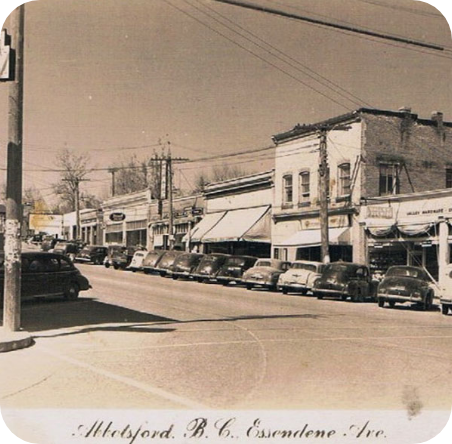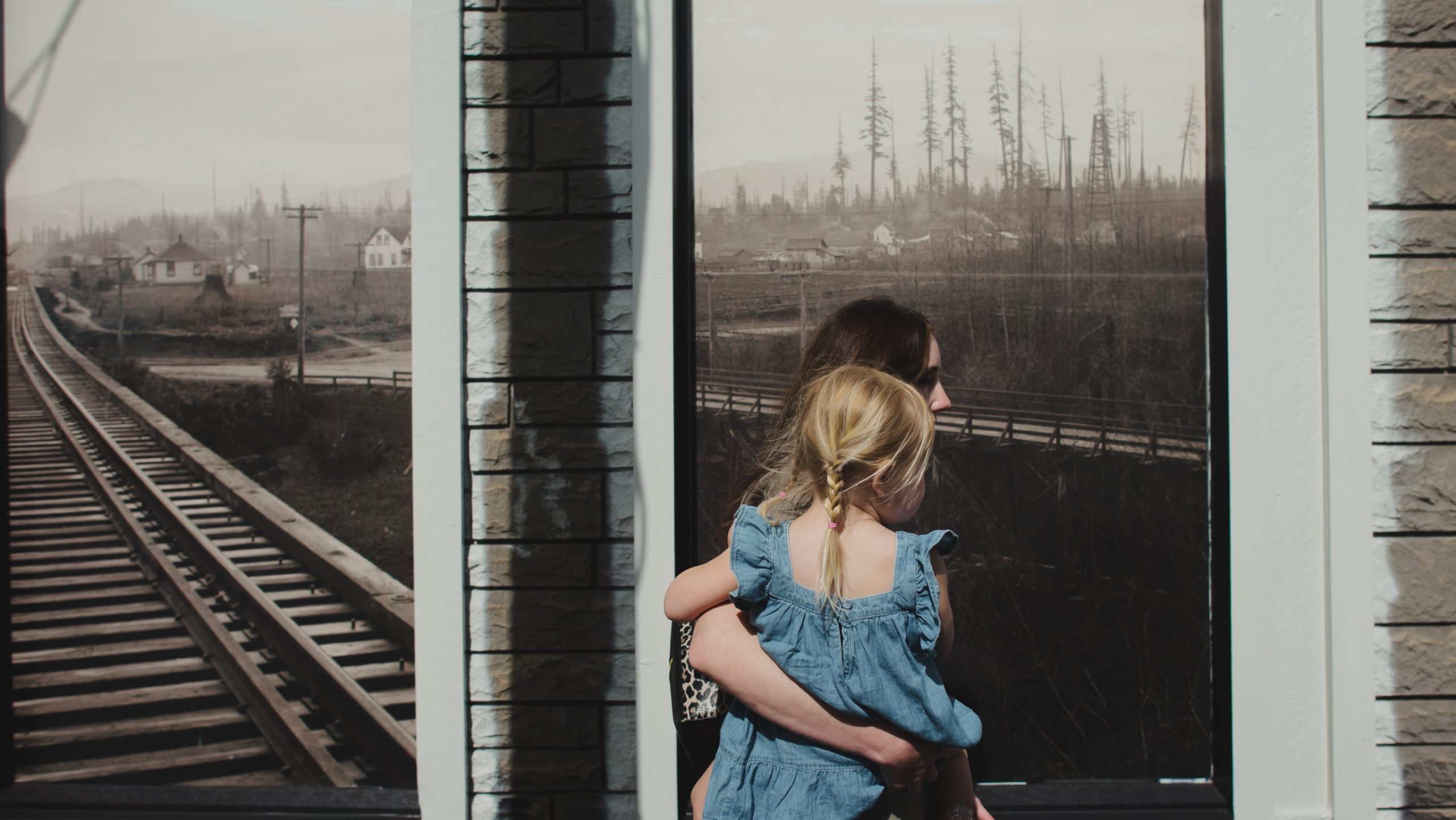HISTORIC DOWNTOWN ABBOTSFORD IS LOCATED ON
S’ólh téméxw, the unceded, traditional, ancestral shared territory of the Semá:th First Nation and Mathxwí First Nation.
These two First Nations are part of the Stό:lō Nation, the People of the River. The Stό:lō people have occupied this territory for more than 10,000 years. What we now call the Fraser River is the Stό:lō. Like much of the community, its original name was replaced with a settler name.



The story of
DOWNTOWN ABBOTSFORD
In the latter half of the 1800’s a colonial development started to take shape in response to the gold rush that occurred in a variety of places in BC. Specific sites along the Fraser River drew hopeful prospectors. Thirty thousand people rushed in to try and make their fortunes. The Governor requested the services of the Royal Engineers to maintain order as well as survey the land. The goal was to reinforce Britain’s claim on the region by promoting the colonization of land with British settlers. One of the roads surveyed was Old Yale Road which was the first transportation route to link the Fraser Valley.
A man by the name of John Cunningham Maclure was a surveyor with the Royal Engineers. He received a crown grant of 160 acres that would later become Abbotsford. He ended up giving it to his son, Charlie Maclure, who quickly sold the land to Robert Ward who then filed the original plan for the Village of Abbotsford in 1891. Abbotsford is named after a Maclure family friend, Harry Abbott, who was the Western Superintendent for the Canada Pacific Railway (CPR).
In 1892, CPR was granted the right of way through Abbotsford and a station was built. Europeans, Japanese, Chinese, and South Asian men were considered early settlers of the area. Over time, Canada’s immigration policy changes creating restrictions on people entering the country based on their ethnic origin. The western rail line construction was a common form of work for many immigrants. Rail travel through the Abbotsford station brought newcomers that also populated the larger adjacent districts of Sumas and Matsqui.
Around WW1, Abbotsford became a hub of train travel as people ‘caught’ the railway fever. Abbotsford was a centralized station that connected Vancouver, Seattle, Victoria, and the Interior together. As time passed more railways came, including the BC Electrical Railway which was for passenger service, and the American rail company, the Great Northern Railway. From 1910 through to the 1920s, the town dealt with numerous fires that burnt down many of the original buildings.
The Village of Abbotsford was incorporated in 1924. More of what we know today began slowly emerging in the late 1920s to early 1930s. At this time saw Jubilee Park being built in 1927, along with the Atangard Hotel which at the time was the most modern hotel in all the Fraser Valley, and went for a grand total of $3.50 per night. In the 1930s the Great Northern Railway tracks were removed and became South Fraser Way. Hansen’s Barbershop was built in 1934 and is downtown Abbotsford’s oldest business.
The hardest disaster to ever hit Abbotsford happened in 1948 when a flood swept through the area of Abbotsford, Chilliwack, and Mission. This flood happened in late May immersing the flood plain in high waters including the railway tracks isolating Abbotsford and other parts of the Fraser Valley from the rest of Canada. It took several weeks for the floodwater to subside, and the town was left with millions of dollars worth of damages.
Abbotsford started taking shape into what we recognize today in the 1950s and 1960s.
Multiple buildings that we may be familiar with were constructed including Hub Motors, the Post Office (Mac and Mango and Zeeba’s Hair), the McLennan, McFeely and Prior Store (Dollarama), the MSA Centennial Library (ADBA Office, Banter Ice Cream, Tourism Abbotsford, and UFV CityStudio) as well as buildings located at what is commonly referred to as ‘Five Corners’ in Abbotsford. Unknown to many, the original Five Corners are located at the intersection of West Railway and Essendene where the Christmas tree has been called home since its planting in 1947.
In 1972, the Village of Abbotsford, the District of Sumas, and the territory of Huntingdon amalgamated to become the District of Abbotsford. Later in 1995, the District of Abbotsford amalgamated with the District of Matsqui to form the City of Abbotsford. The original core of Abbotsford all those years ago when it was first incorporated is what is known today as the Historic Downtown. Over the past decade, a great deal of revitalization has occurred. Home to over 200 businesses, it is now a bustling part of the city and a thriving area where the fundamental values of supporting local makers, supporting the community, and supporting one’s neighbors are key to its success.
In the downtown, the oldest part of our city, if one pulled back the ‘layers’ of improvements done over time, one would find an amazing history connected to its streets and buildings. There are few remaining sites where the buildings resemble their original beginnings. These buildings, scattered throughout the downtown are considered by the City of Abbotsford as buildings that should be retained or reconstructed to appear the same as they do today. These buildings include the Old Court House (Archway Community Services), the Atangard Hotel (the Atangard Community Project apartments), as well as the former Daly’s Department Store (Van Bree Tattoo and Original Hot Yoga), Essendene Mall (Ton Khao Thai Cuisine and Razor’s Edge Hair Gallery Beauty and Spa), the Crist Building (Open Space and The Social Salon), and the old Post Office (Mac and Mango, Zeeba’s and Tenfold Tattoo Gallery). These “Facade Retention” buildings are noted in the City of Abbotsford Historic Downtown Neighbourhood Plan.
The Abbotsford Downtown Business Association has available copies of a book entitled Downtown Abbotsford, A Walking Tour. This book was authored by a group of students in Nancy Hutsul’s Challenge Class at W.A Fraser Middle School in 2009 and published by The Reach. Grab a copy from the ADBA office located at 210 – 33660 South Fraser Way, put on your walking shoes, buy a coffee from one of downtown’s great cafes, and enjoy a historical walk downtown.
TAKE A WALKING TOUR WITH
ON ThIS SPOT
Check out the amazing ON THIS SPOT app that will take you on a walking tour of downtown Abbotsford. With over 130 years of changes viewed through photos of ‘then and now’ depicting what was noted by then the owner of 160 acres of granted land, John Cunningham Maclure, in 1889 as ‘the promised land, you will be amazed at how far we have come.
WANT MORE INFORMATION ON DOWNTOWN ABBOTSFORD’S HISTORY?
CHECK OUT THESE RESOURCES:
The Reach Art Gallery (The Reach Gallery Museum)
Resources and historical archives of the town as well as a database of archival photographs. Historical Archives: 50s and Archival Photo Database
For any specific questions regarding the history of downtown Abbotsford please contact Kris Foulds the Curator of Historical Collections at kfoulds@thereach.ca or call at 604 864-8087 x 122
Heritage Abbotsford for general Abbotsford history
Canada’s Immigration Policy Canadian Immigration Acts and Legislation | Pier 21

